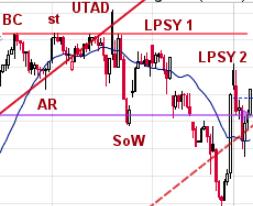Wyckoff at Work in the Intraday Timeframe
In the fast-paced world of intraday trading, one of the methods that traders often turn to for guidance is the Wyckoff trading method. Developed by Richard D. Wyckoff in the early 20th century, this approach focuses on understanding the intentions of large traders and institutions in order to anticipate market movements. While it is commonly applied to longer timeframes, the principles of the Wyckoff method can also be effectively utilized in the intraday timeframe to make informed trading decisions.
At the core of the Wyckoff method is the concept of analyzing price and volume to assess market dynamics. By studying how price moves in relation to volume, traders can gain insights into the strength or weakness of a trend. In the intraday timeframe, this analysis becomes even more crucial due to the rapid pace at which prices fluctuate. By focusing on volume surges and price relationships within shorter time intervals, traders can identify potential entry and exit points with higher precision.
One key principle of the Wyckoff method is the concept of accumulation and distribution. During the accumulation phase, large traders accumulate positions while keeping prices stable, causing an apparent range-bound movement. This phase is often characterized by increasing volume and diminishing price volatility. In the intraday timeframe, traders can look for signs of accumulation through the gradual increase in volume without significant price shifts, indicating potential buying interest.
Conversely, the distribution phase occurs when large traders start offloading their positions, leading to a decline in prices. This phase is marked by high volume and increasing price volatility as traders rush to sell their holdings. In the intraday timeframe, this distribution phase can manifest as sudden spikes in volume accompanied by sharp price reversals, signaling a potential downtrend.
Another key aspect of the Wyckoff method is the analysis of price patterns, such as springs and upthrusts, to gauge the strength of a trend. Springs occur when prices temporarily dip below a support level before quickly rebounding, indicating strong buying interest. Intraday traders can watch for spring patterns as potential entry points for long positions, taking advantage of the temporary price dip.
On the other hand, upthrust patterns occur when prices briefly breach a resistance level before reversing course, signaling potential weakness in the trend. Intraday traders can use upthrust patterns as signals to exit or reverse their positions, capitalizing on the impending price reversal.
In conclusion, the Wyckoff method offers a comprehensive framework for intraday traders to analyze market dynamics and make informed decisions. By focusing on price and volume analysis, as well as identifying accumulation and distribution phases, traders can anticipate market movements with greater accuracy. By incorporating the principles of the Wyckoff method into their intraday trading strategies, traders can enhance their profitability and navigate the fast-paced intraday markets with confidence.

